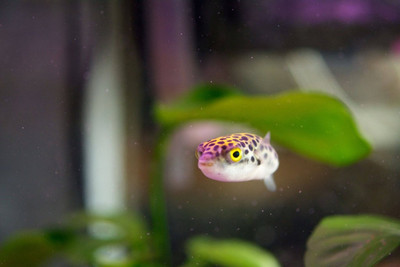Green Spotted Pufferfish
Posted by Max Gandara on on 14th May 2025
Green Spotted Pufferfish: The Bright-Eyed Brute of Brackish Waters
Cute, charismatic, and full of personality—the Green Spotted Pufferfish (Dichotomyctere nigroviridis) is one of the most intriguing fish you can keep. With its bright green back, bold black spots, and constantly curious nature, this puffer can quickly become the centerpiece of your tank.
But don’t let its innocent look fool you. Behind those googly eyes is an intelligent, demanding, and sometimes aggressive predator that needs specific care, especially when it comes to water chemistry and long-term tank planning.
Meet the Green Spotted Puffer
Native to Southeast Asia, the Green Spotted Puffer (often abbreviated as GSP) is found in fresh, brackish, and coastal marine waters. It starts life in freshwater but gradually migrates toward saltwater habitats as it matures. This shift in salinity is crucial to understand when keeping them in captivity.
Quick Facts:
-
Scientific Name: Dichotomyctere nigroviridis
-
Adult Size: Up to 6 inches (15 cm)
-
Lifespan: 10+ years with proper care
-
Tank Level: Active mid-level swimmer
-
Temperament: Intelligent, curious, semi-aggressive
Freshwater or Saltwater? Brackish Is the Key
One of the most common mistakes new owners make is assuming the GSP is a freshwater fish. As juveniles, they can live in freshwater. But as they grow, they require brackish to fully marine conditions.
Salinity Guidelines:
-
Juveniles (<2 inches): Freshwater to low brackish (SG 1.002–1.005)
-
Sub-adults (2–4 inches): Brackish (SG 1.006–1.010)
-
Adults (4+ inches): High brackish to marine (SG 1.015–1.020+)
You'll need a refractometer and marine salt mix to maintain proper salinity—aquarium salt is not enough.
Tank Setup and Requirements
Green Spotted Puffers are messy eaters and need excellent filtration and water quality.
Minimum Tank Size:
-
Juvenile: 20–30 gallons
-
Adult: 55+ gallons (preferably 75+)
Environment:
-
Substrate: Sand or fine gravel
-
Décor: Rockwork, mangrove roots, and plenty of hiding spaces
-
Plants: Use hardier brackish/marine-tolerant plants like java fern or Anubias (attached to décor)
Water Parameters:
-
Temperature: 76–82°F (24–28°C)
-
pH: 7.8–8.5
-
Ammonia & Nitrite: 0 ppm (they are highly sensitive)
-
Salinity: See above based on life stage
Use a canister filter or sump, and perform weekly 30–50% water changes.
Diet and Beak Maintenance
GSPs are carnivores with strong beaks that continue growing throughout their life. If not kept in check, the beak can overgrow and cause feeding issues.
Feed a varied, crunchy diet:
-
Snails (ramshorn, pond, bladder): Crucial for beak trimming
-
Clams, mussels, shrimp (in shell)
-
Crustaceans and crabs
-
Occasional bloodworms or krill
Avoid soft, flake-based diets. GSPs are active hunters and need stimulation as well as nutrition.
Behavior and Tank Mates
Green Spotted Puffers are not community fish. Their intelligence makes them curious and interactive, but also territorial and aggressive, especially in confined or improperly stocked tanks.
Best Practice:
-
Species-only tank is ideal
-
Occasionally cohabited with tough, fast brackish companions (e.g., scats or monos), but only in very large tanks
Avoid:
-
Slow or small tankmates (they’ll nip or kill them)
-
Other puffers (unless breeding or highly experienced)
Personality and Intelligence
GSPs are highly intelligent. They recognize their owners, learn routines, and will actively explore their surroundings. Many hobbyists say their GSP acts more like a dog than a fish.
To keep them stimulated:
-
Rearrange décor occasionally
-
Provide live prey or food puzzles
-
Use target feeding and interactive tools
Common Health Issues
1. Overgrown Beak
-
Cause: Lack of hard-shelled food
-
Solution: Provide crunchy foods or trim beak (by a vet or experienced keeper)
2. Internal Parasites
-
Many are wild-caught and may carry worms
-
Solution: Quarantine and treat with anti-parasitics like praziquantel
3. Poor Salinity Management
-
Freshwater-only setups can shorten lifespan or cause organ failure
Final Thoughts
The Green Spotted Pufferfish is not your average aquarium pet. With proper care, it can live over a decade, recognize your face, and even beg for food like a puppy. But it requires brackish to marine care, a specialized diet, and a dedicated setup.
If you're up for the challenge, the GSP offers one of the most rewarding and interactive fishkeeping experiences out there.
Pro Tip: Buy from reputable sources that offer healthy, parasite-free puffers, and always quarantine new arrivals!

